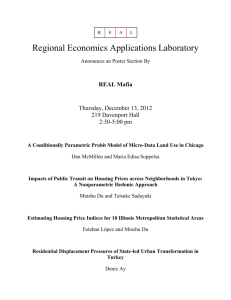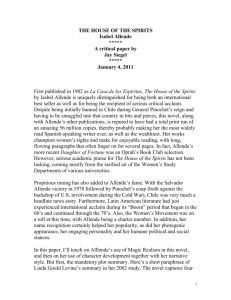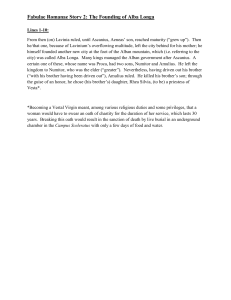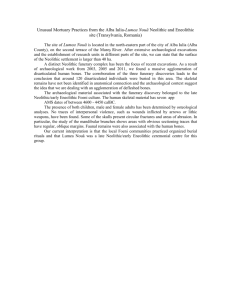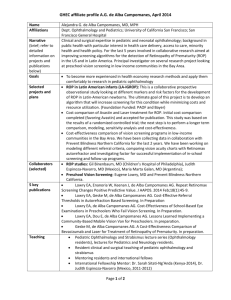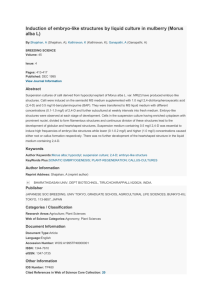The Rise of Female Narration and Women's History in Isabel
advertisement
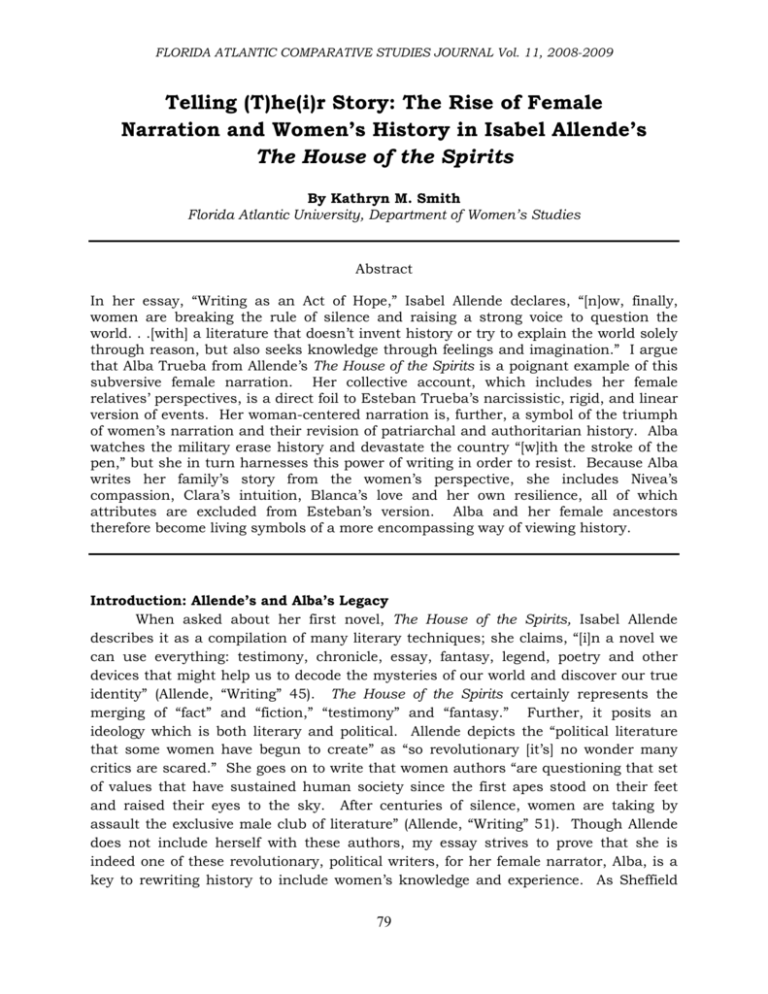
FLORIDA ATLANTIC COMPARATIVE STUDIES JOURNAL Vol. 11, 2008-2009 Telling (T)he(i)r Story: The Rise of Female Narration and Women’s History in Isabel Allende’s The House of the Spirits By Kathryn M. Smith Florida Atlantic University, Department of Women’s Studies Abstract In her essay, “Writing as an Act of Hope,” Isabel Allende declares, “[n]ow, finally, women are breaking the rule of silence and raising a strong voice to question the world. . .[with] a literature that doesn’t invent history or try to explain the world solely through reason, but also seeks knowledge through feelings and imagination.” I argue that Alba Trueba from Allende’s The House of the Spirits is a poignant example of this subversive female narration. Her collective account, which includes her female relatives’ perspectives, is a direct foil to Esteban Trueba’s narcissistic, rigid, and linear version of events. Her woman-centered narration is, further, a symbol of the triumph of women’s narration and their revision of patriarchal and authoritarian history. Alba watches the military erase history and devastate the country “[w]ith the stroke of the pen,” but she in turn harnesses this power of writing in order to resist. Because Alba writes her family’s story from the women’s perspective, she includes Nivea’s compassion, Clara’s intuition, Blanca’s love and her own resilience, all of which attributes are excluded from Esteban’s version. Alba and her female ancestors therefore become living symbols of a more encompassing way of viewing history. Introduction: Allende’s and Alba’s Legacy When asked about her first novel, The House of the Spirits, Isabel Allende describes it as a compilation of many literary techniques; she claims, “[i]n a novel we can use everything: testimony, chronicle, essay, fantasy, legend, poetry and other devices that might help us to decode the mysteries of our world and discover our true identity” (Allende, “Writing” 45). The House of the Spirits certainly represents the merging of “fact” and “fiction,” “testimony” and “fantasy.” Further, it posits an ideology which is both literary and political. Allende depicts the “political literature that some women have begun to create” as “so revolutionary [it’s] no wonder many critics are scared.” She goes on to write that women authors “are questioning that set of values that have sustained human society since the first apes stood on their feet and raised their eyes to the sky. After centuries of silence, women are taking by assault the exclusive male club of literature” (Allende, “Writing” 51). Though Allende does not include herself with these authors, my essay strives to prove that she is indeed one of these revolutionary, political writers, for her female narrator, Alba, is a key to rewriting history to include women’s knowledge and experience. As Sheffield 79 SMITH: FEMALE NARRATION AND HISTORY IN THE HOUSE OF SPIRITS puts it, “through rewriting,” such as is evident in The House of the Spirits, “memories that history ignores are preserved and given voice” (34). At the conclusion of The House of the Spirits, Alba Trueba acknowledges the many women who contributed to her knowledge, including her grandmother Clara, who played an integral role in recording the del Valle-Trueba women’s history. Alba asserts, “Clara wrote them [her notebooks] so they would help me now to reclaim the past and overcome terrors of my own. The first is an ordinary school copybook with twenty pages, written in a child’s delicate calligraphy. It begins like this: Barrabas came to us by sea…” (Allende 433). The significance of this finale is that it mirrors the first sentences of the novel: “Barrabas came to us by sea, the child Clara wrote in her delicate calligraphy. She was already in the habit of writing down important matters and afterward, when she was mute, she also recorded trivialities, never suspecting that fifty years later I would use her notebooks to reclaim the past and overcome terrors of my own” (Allende 1). By introducing and concluding The House of the Spirits in this way, Alba solidifies the circularity of the women’s testimony and experience. The two passages serve as proverbial bookends, buttressing the women’s stories. Even more importantly, the beginning and ending are not just parallel, but inversions of one another. Given the political and historical focus of Allende’s book, I posit that the inversion of these passages is symbolic of the way in which Alba is inverting and subverting patriarchal text. She actively takes her grandfather Esteban’s accounts, as well as the dictatorship’s history, and construes them to her own purposes of continuing her family’s legacy. In addition, she consciously writes in a circular manner, which undermines the traditional, linear manner in which history is usually written. She declares that she has been implementing Clara’s notebooks, as well as Nivea’s photographs, Blanca’s letters, and her own experiences, to both “reclaim the past” and “overcome terrors of [her] own.” Alba’s purpose, then, is twofold: to recover her female ancestors’ story and to sustain herself through their empowerment. Alba’s voice, however, is not the only one in the novel. Esteban Trueba is a formidable patriarch who strives to dominate the women in his family throughout the novel, and his style of narration is no exception. As he records his own version of his life, he declares, “[n]o one’s going to convince me that I wasn’t a good patrón. Anyone who saw Tres Marías in decline and who could see it now, when it’s a model estate, would have to agree with me. That’s why I can’t go along with my granddaughter’s story about class struggle” (Allende 51). Esteban’s rigid, linear account in The House of the Spirits is a direct foil to Alba’s circular narration, which includes her female ancestors’ stories. As a stubborn patriarch, Esteban insists on his correctness even in the face of overwhelming evidence to the contrary, such as Clara’s notebooks, which Alba uses to write a more encompassing story. His account, then, is fully subjective and written to justify himself and his actions, whereas Alba’s account is an attempt to recreate her family’s history, with the cooperation of all her female relatives. Because Esteban influences all of the female characters in The House of the Spirits – his wife 80 FLORIDA ATLANTIC COMPARATIVE STUDIES JOURNAL Vol. 11, 2008-2009 Clara, his daughter Blanca, and his granddaughter Alba – his biased narration often threatens to overtake the force of the women’s stories. Despite his overwhelming presence, however, I argue that Alba’s narration overcomes Esteban’s influence and recovers the stories of her female ancestors, giving them as well as herself a legacy. Her woman-centered account is, further, a symbol of the triumph of women’s narration and their revision of patriarchal and authoritarian history. Esteban’s Account: A Patriarchal Perspective A close study of Esteban’s narrative style reveals the gaps in his account, due to his age but more significantly due to his selective memory and retelling. He repeatedly admits that “[m]ore than a half of a century has passed” and he acknowledges that his memory is, therefore, blurred. Moreover, he sometimes needs to rely on third-person witnesses, such as is the case concerning the death of his fiancée, Rosa the Beautiful. Esteban tells the reader of his visit to the cemetery and of his reaction to her death: “‘Damn her! She slipped through my hands!’ they say I shouted” (Allende 34, emphasis mine). The importance of “they say” is that it illustrates Esteban’s memory loss and lessens the credibility of his version. If Esteban cannot remember his violence at Rosa’s grave, instead referring to what other people say happened, then maybe there are other important events, especially violent ones, that he is forgetting. The incident of Rosa’s death also reveals aspects of Esteban’s character: his extreme and uncontrollable anger, violence, and possessiveness. He not only curses Rosa, the supposed love of his life, for slipping through his hands, but he also relates that, if he knew she were going to die soon, he “would have kidnapped her and locked her up, and only [he] would have had the key” (Allende 36). This possessive and aggressive behavior is indicative of Esteban’s general attitude toward women, which is later demonstrated in his relationship with Clara, Rosa the Beautiful’s younger sister. Esteban’s love for Clara soon evolves from affectionate indifference to consuming fixation: “In all that time his love for her [Clara] had grown to the point where it had become an obsession. He wanted Clara to think of nothing but him, and he could not bear for her to have a life outside that did not include him. […] He wanted her to be completely dependent” (127). Not only does Esteban wish to control Clara’s mind, but he also exerts dominance over her body, such as when he knocks out her front teeth in a fit of rage. His narration, therefore, is not to be believed when he writes, “[i]f I had to do it over again, there are a few mistakes I wouldn’t make, but in general there’s nothing I regret” (Allende 54). Significantly, Esteban tries to gloss over many of his mistakes, and it is only Alba, using Clara’s notebooks and her mother’s testimony, who exposes the reality of these errors. Sheffield argues this point in her article, “Voices from the Political Abyss: Isabel Allende’s The House of the Spirits and the Reconstruction and Preservation of History and Memory in 1970s Chile and Beyond,” averring: In narrating Trueba’s story, Alba shares and contextualizes more than Trueba is willing. For example, in the ‘Tres Marias’ chapter, Trueba does not share the stories of his 81 SMITH: FEMALE NARRATION AND HISTORY IN THE HOUSE OF SPIRITS rapes of peasant women. […] Without Alba’s explication, Trueba would eliminate memories of such things as his rapes of peasant girls […] because to him, and the dominant political machine, those things are insignificant. (Sheffield 35) The women whom Esteban rapes are not notable to him because he views them as his property and feels entitled to use them as sexual objects. In fact, as “[w]ord of his cruelty spread throughout the region,” the peasants “hid their daughters and clenched their fists helplessly because they could not confront him” (Allende 63). Because Esteban is the patrón, he thinks that he owns not only the land but the people as well, and as he is both patriarch and tyrant, the peasants are powerless to stand up against him. This attitude continues from his time as patrón all the way until he recounts his life for Alba’s book. Even in remembering his past, he refuses to admit that he has made any mistakes, perhaps thinking of his sexual violence as normal behavior for a man of his wealth and stature. Esteban’s ravenous appetite for sex as well as power continues in his relations with Tránsito Soto, a prostitute to whom he returns several times in The House of the Spirits. The imperative part of these sexual encounters, however, is not that Esteban participates in them but that he tries to hide them. It is important to note that, although Tránsito was a constant presence in Esteban’s life, he would not have recounted her if she did not prove to be such an essential contact later.1 Esteban admits: “I wouldn’t have mentioned this episode if Tránsito Soto hadn’t played such an important role in my life a long time later, because, as I said earlier, I’m not a man for whores” (Allende 119). As a political figure who is conscious of what he should and should not include in his memoir, Esteban certainly would not have written about the prostitute with whom he consorted throughout the novel, nor the bastard children whom he fathered at Tres Marías. In the case of Tránsito, Esteban is forced to incorporate her in his story because she rescues Alba from imprisonment and torture; otherwise, we might rightly assume that this duty of telling the truth, just like in the 1 Tránsito’s influence in the novel is crucial because she is the one who saves Alba from imprisonment when Esteban, despite all of his governmental connections, is impotent. Kavita Panjabi has written a poignant essay focusing on Tránsito’s power, entitled “The House of the Spirits: Tránsito Soto: From Periphery to Power.” In this essay, Panjabi states that Tránsito “occupies a central position of power in the subjectivity of not only Esteban but also her other clients, the generals in power; and this gives her the leverage by which to gain control over them. She eventually uses this unique power to rescue the feudal patriarch’s granddaughter, the socialist Alba from the military hierarchy, but what is as important as the actual subversion is the use to which this gained power is put. Tránsito achieves a certain degree of control in the political domain, and she uses it not for the perpetuation of the same power politics that already vilify it, but to saving life instead of destroying it; she uses it to rescue another woman from the clutches of torture and political intrigue” (15). 82 FLORIDA ATLANTIC COMPARATIVE STUDIES JOURNAL Vol. 11, 2008-2009 case of Esteban’s rapes, would have been left to Alba, the novel’s more reliable and consistent narrator.2 Alba’s Testimony: A Conscious Collective Alba’s narration differs greatly from Esteban’s in that her story is a collection of women’s experiences. She does not claim to know everything herself, which explains the general lack of first-person voice in her narration. According to Sheffield, “throughout most of the novel, [Alba] maintains the role of third-person narrator, only rarely inserting a secondary, unobtrusive ‘I’ into the line of the text but, overall, maintaining such a degree of separation” that it proves her story as more credible (Sheffield 34). One of the rare examples in which Alba claims first-person knowledge is in the quote discussed earlier: “Clara wrote them [her notebooks] so they would help me now to reclaim the past and overcome terrors of my own” (Allende 433). In this scenario, Alba uses her first-person knowledge to direct the attention back to her female ancestors, not to herself. Susan Frick elucidates Alba’s unique narrative style in the essay, “Memory and Retelling: The Role of Women in La casa de los espíritus.” Frick asserts that in Alba’s woman-centered form of narration, she is “tapping into collective memory to evoke and interpret the stories and voices of the past and to learn how best to proceed with her own individual life experience” (Frick 29). Alba acknowledges that she is a participant in her family’s story, but more importantly she situates herself as part of the legacy of the Trueba women, telling her story in league with her grandmother Clara and her mother Blanca.3 It is only in the epilogue that Alba reveals her identity as the latest link in the Trueba women. This switch from third-person to first-person voice is not accidental, but is a sign that her and her female relatives’ stories have overcome Esteban’s patriarchal narration. Frick posits that, “[h]aving brought together her female ancestors’ experiences and her grandfather’s male perspective, Alba is finally ready to admit to being the first-person narrator of La casa de los espíritus” (Frick 37). Further, Sheffield proposes that Alba’s mixing of first- and third-person is actually a technique called “the objective/subjective position” (34). Whereas Esteban’s approach is what Sheffield terms “capitalistic appropriation/ownership of the story” (consistently subjective and biased), Alba avoids this appropriation of the family’s history by admitting that her information comes from other sources, such as Clara’s 2 Literary scholar Elizabeth Espadas expands on Esteban’s flawed narration, stating: “The idea of multiple versions of events […] is well-captured through the case of Esteban Trueba. In his own analysis of himself, he is a self-made man, a wise provider, and a just father-figure to his childlike tenant farmers, while from a female perspective, he is seen to be an arbitrary, violent, and despotic man, as well as rapist, who overtly seeks material wealth in lieu of developing humanistic values and who is generally abusive toward females, be they the peasant girls he regularly violates or his own wife, whose front teeth he knocks out while in a rage” (134). 3 Alba’s great-grandmother, Nivea del Valle, is an important character in the del Valle-Trueba tradition, and her photographs provide glimpses into the family’s history, but she is not a significant part of Alba’s personal life. Because my essay is focusing on Alba’s narration and the influences surrounding it, I choose not to elaborate upon Nivea at this time. 83 SMITH: FEMALE NARRATION AND HISTORY IN THE HOUSE OF SPIRITS notebooks that bear witness to life. Her account is more like a cooperative documentary than a first-person account, and this “subjective/objective position” not only lends her credibility but, even more importantly, “allows for the deeply personal accounts of individual people, memories, and stories in the novel while preventing the appearance of personal bias” (Sheffield 34). Alba can, then, include Clara’s, Blanca’s, and even Nivea’s personal stories through their first-person documents while also using her own perspective to fill in the gaps and to include herself as the latest Trueba woman. Alba’s narration, because of its subjectivity and objectivity, is more complete than Esteban’s, which strives to persuade, not inform, the reader. Literary Influences While Alba’s objective/subjective position is pretty clear, it is unclear as to why she allows her grandfather to narrate at all, given his tyrannical and patriarchal tendencies. One reason for this inclusion of the male perspective could be that Alba is not only her grandfather’s pet, but that she has also seen him in the more mellow years of his life. Alba, in her third-person voice, tells us, “Esteban Trueba, who had always found it difficult to express his emotions and had no access to tenderness ever since his relationship with Clara had deteriorated, transferred all his finest sentiments to Alba. The child meant more to him than his own children ever had” (Allende 274). Even Clara, Esteban’s estranged wife, sees a difference in his usually aggressive behavior: The presence of his granddaughter sweetened Esteban Trueba’s character. The change was imperceptible, but Clara noticed it. Slight symptoms gave him away: the sparkle in his eyes when he saw the little girl, the expensive presents he bought her, and the anguish he felt if he heard her cry. (Allende 266) It is obvious from these passages that Alba received many kindnesses from her grandfather that nobody else in the family had ever known. She is consequently the character who is most sympathetic toward Esteban, and grandfather and granddaughter share a close bond. Even so, Alba is not naïve when it comes to her grandfather’s past. She knows from both Clara’s and Blanca’s experiences that Esteban can act as an oppressor and that he tends to exclude the negative consequences of his actions. Literary critic Flora Schiminovich recognizes Esteban’s patriarchal narration and character, arguing that “Trueba’s ‘truth’ is the ideology of patriarchy, capitalism, dominance, and politically dictated history and memory; he only begins to realize it is a falsehood after his granddaughter, Alba, returns from the government torture camp and tells her story” (35). Schiminovich’s incorporation of the torture camp in Esteban’s transformation leads to yet another reason for dual narrators: Esteban is, simply, the one who insists that Alba write her family’s history. Clara’s spirit appears to Alba when she is a political prisoner, but Esteban continues to urge Alba to record the family legacy. As 84 FLORIDA ATLANTIC COMPARATIVE STUDIES JOURNAL Vol. 11, 2008-2009 Alba notes, “It was my grandfather who had the idea that we should write this story. ‘That way you’ll be able to take your roots with you if you ever have to leave, my dear’ he said” (Allende 430). Moreover, Esteban has lived through things that Alba can never write about, even with her grandmother’s diaries and her mother’s letters and confidence, so it benefits Alba to incorporate his memories. She tells us, “I began to write with the help of my grandfather, whose memory remained intact down to the last second of his ninety years” (Allende 431). Whether Alba is critical of her grandfather’s memory, it is hard to glean from this quote, but most likely she appreciates his memory for the insight he provides, while she fills in or corrects the story when the details are inaccurate. We must not forget, also, Clara’s spiritual presence and guidance in the writing of the del Valle-Trueba story. As Alba informs us, “She [Clara] helped us write, and thanks to her presence Esteban Trueba was able to die happy, murmuring her name: Clara, clearest, clairvoyant” (Allende 431). The fact that Esteban completes his family’s story and then lies down on Clara’s bed to die in peace is similar to what Martinez posits in “The Politics of the Woman Artist in Isabel Allende’s The House of the Spirits.” Martinez writes: “[t]o symbolize his [Esteban’s] redemptive awareness, Allende makes him assist in the telling of the story, done by the main narrator, Alba” (Martinez 290). In this way, Esteban contributes to the women’s story and, in the process, is partially redeemed for his mistakes (even those he refuses to admit). Esteban and Clara, however, are not the only ones who contribute to Alba’s narration. The women in the detention camp play an integral role in supporting Alba and continuing women’s history. At one point in the novel, at the height of the military coup’s reign of terror, Alba is forcefully taken from her home and thrown into a political prison where she is beaten, raped, and tortured. After Colonel García and the other men are finished with her, they leave her in a detention camp with other women who have undergone similar experiences, unaware of the power of this women’s collective. Though Alba longs for the relief of death, the women surrounding her renew her strength, and encourage her to tell her/their story. They give her notebooks and support her as she begins the difficult journey of writing as resistance. Alba states: I had managed to resist the inferno with certain integrity, but when I felt so much support, I broke down. The smallest expression of tenderness sent me into a crying fit. I spent the night with my eyes wide open, wrapped in the closeness of so many women, who took turns watching over me and never left me alone. They helped me whenever I began to suffer from bad memories or when I saw Colonel García coming to plunge me back into his world of terror. (Allende 426) The fact that Alba was “wrapped in the closeness of so many women” is vital to The House of the Spirits because otherwise the women’s story might never have been told. As Sheffield argues, the “feminine collective” of the detention camp “provides the 85 SMITH: FEMALE NARRATION AND HISTORY IN THE HOUSE OF SPIRITS support Alba needs to present the revision of history present in the novel; it is the chorus of women’s voices following behind her that gives Alba the ability to write and preserve their (and her) testimonies” (Sheffield 37). The Writing of History: Woman-Centered Narration Thus far, I have compared the narrative styles of Alba and Esteban Trueba, elucidating their differences and demonstrating how Esteban’s narrative is riddled with falsifications. Now, I want to further my argument by declaring that, just as Alba’s objective/subjective, woman-centered writing overcomes Esteban’s domineering style, so is The House of the Spirits an example of women’s history overtaking traditional, or men’s, history. Peter Earle explores such conflicting histories – capitalistic versus collective, male versus female, patriarchal versus egalitarian – in his essay, “Literature as Survival: Allende’s The House of the Spirits.” Earle argues that “[t]he dramatic nucleus of the book is the struggle between Trueba and the forces he generates, on the one hand, and the female members of his family, on the other” (550). To Earle, Esteban Trueba “is the blind force of history” along with all of “its aggressive, vigorous, physical manifestations” (Earle 550). In other words, Esteban and his authoritarian political party create one history, while Alba and her female ancestors battle this aggressive hegemony with their own, alternative histories. Evidence from The House of the Spirits abets Earle’s and other critics’ views; for example, when Esteban reflects upon his role as patrón to the peasants of Tres Marías, he says, “What you need here is a strong government, with a strong man. It would be lovely if we were all created equal, but the fact is we’re not. It couldn’t be more obvious” (Allende 64). This is what Esteban means when, earlier in the novel, he declares that he “can’t go along with [his] granddaughter’s story about class struggle” (Allende 51). Esteban believes that men like him should control not only politics, but the people themselves, and that history (including his) should be written from the point of view of the elite. Another example of Esteban’s version of history is shown when the military coup occurs. Alba observes the way in which the new regime censors and rewrites history; she writes, “[w]ith the stroke of the pen, the military changed world history, erasing every incident, ideology, and historical figure of which the regime disapproved” (Allende 383). Esteban supported the military coup and its leaders, therefore his views are reflected in the ways that the military dictatorship writes history. Sheffield adds to Earle’s treatment of dual narrations/histories by suggesting that Esteban’s narration serves as a foil to Alba’s. As Sheffield claims, The two narrators, Alba and Trueba, provide the reader with a view of both the dominant history taught in schools and the subversive women’s memories in the novel. The differences in their narrative voices serve to highlight the single-minded linear view held by Trueba, and others within the dominant group, as the negative and repressive one. Through Alba’s abundant vision and memory, and Trueba’s 86 FLORIDA ATLANTIC COMPARATIVE STUDIES JOURNAL Vol. 11, 2008-2009 tendency toward narrow-mindedness, we catch a glimpse of two distinct worlds, and through those worlds, we are offered a re-vision of history. (Sheffield 34) Sheffield and Earle both directly link Esteban to the oppressive governmental regime which imprisons Alba. In a sense, like the government, Esteban tries to imprison all of the women in his life, physically and emotionally, until the disappearance of his granddaughter makes him realize that he should separate himself from the authoritarian military in power. It is only then that Esteban encourages and helps Alba to write the del Valle-Trueba story. Alba watches the military erase history and devastate the country “[w]ith the stroke of the pen,” but she in turn harnesses this power of writing to make gains for women. As Earle maintains, Alba employs a “more imaginative, more perceptive resistance” to Esteban’s and the government’s patriarchal domination. Earle states that “Clara, Blanca, and Alba […] embody historical awareness and intuitive understanding. Their role throughout the novel is the preservation of moral and social conscience and civic responsibility” (Earle 551). Alba and her female ancestors are living symbols of a different way of viewing history. Because Alba writes her family’s story from the women’s perspective, she includes Nivea’s compassion, Clara’s intuition, Blanca’s love and her own resilience, all of which attributes are excluded from Esteban’s version. In the essay, “Authorizing Female Voice and Experience: Ghosts and Spirits in Kingston's The Woman Warrior and Allende's The House of the Spirits,” literary critic Ruth Jenkins illustrates Kingston’s and Allende’s particularly woman-centered modes of writing. She writes that, “[m]ore than defying poor memory, these narratives record stories of female experience neither sufficiently nor authentically articulated by histories constructed from patriarchal perspectives” (Jenkins 66-7). Jenkins further contends that The House of the Spirits is an especially potent example of “the power to script history” because “Allende asserts the value of individual female experience while weaving it into generations of female history” (66). Once again, we return to the way in which the individual and collective nature of Alba’s narration sets it above Esteban’s single-minded memoirs. Just by focusing on her female relatives, Alba confers to them and herself an importance and also a subversive quality. The del Valle-Trueba women are depicted as legitimate historical actors, even when patriarchal history, such as that created by Esteban and his male contemporaries, refuses to acknowledge them. Gabrielle Foreman takes this point even further in “Past-On Stories: History and the Magically Real, Morrison and Allende on Call.” She claims that “The House of the Spirits is a femino-centric novel in that the female characters here are not in the traditional roles found in masculine writing, rather they constitute […] gynoforces that challenge patriarchal despotism, social-sexual prejudices, the dictatorship and political repression” (Foreman 378). To Foreman, the female characters and the novel, The House of the Spirits, are very real challenges to “masculine writing” and “political repression.” 87 SMITH: FEMALE NARRATION AND HISTORY IN THE HOUSE OF SPIRITS Indeed, the themes and structure of The House of the Spirits are a poignant statement against typically male writing and history. As Sheffield points out, “Allende’s focus on what have traditionally been considered unimportant, ahistorical stories (namely stories of women), and her refusal to structure the novel along traditional historical lines, is a subversion of linear tradition” (Sheffield 34). When Esteban narrates his side of the story, he writes more or less in the “linear tradition” and includes only those events which he considers “important” and worthy of remembrance. Alba, on the other hand, uses Clara’s notebooks, which are “divided according to events and not in chronological order, just as she arranged them before she left” (Allende 433). She strives, with her grandmother’s notebooks, her mother’s letters, and many other family documents, to piece together the family’s story in a way that connects events instead of simply recording them. Alba explains that, without an alternative, collective, and inclusive history, events do not relate to one another and life seems fragile and chaotic. She writes that “the space of a single life is brief, passing so quickly that we never get a chance to see the relationship between events; we cannot gauge the consequences of our acts, and we believe in the fiction of past, present, and future, but it may also be true that everything happens simultaneously” (Allende 432). Esteban’s narration is an example of how a chronological record can include the main points of one’s life while omitting any accountability for “the consequences of our acts.” According to Alba and her female relatives, linear history is not the only way to record events, and Alba’s conscious narration of the del Valle-Trueba legacy remains a more encompassing approach to life and history. In this way, Alba serves as the human link between history and fiction and between reality and imagination, bridging the gap between the past and present with the political and personal stories of the spirits inhabiting her house and her familial history. As she remembers her foremothers, Alba perpetuates a cyclical repetition of the human experience, one which prevents time from becoming simply a linear progression of events and ensures a connection between herself and her predecessors across all spatial and temporal boundaries. (Frick 27) In beginning and ending The House of the Spirits the way she does, Alba emphasizes the circularity of her family’s woman-centered history, and once again solidifies her position as the objective/subjective narrator who is the “human link” between the past and the present. Breaking that Terrible Chain: Writing as Resistance Though Alba’s purpose in writing is mainly to record her family’s history from a female perspective, she also has her own motive: she writes to survive the trauma she has undergone and begin her life anew. As Frick maintains, “remembering evolves as 88 FLORIDA ATLANTIC COMPARATIVE STUDIES JOURNAL Vol. 11, 2008-2009 an empowering cultural response to trauma, through which the stories of the past are retold in an effort to shape the present and the future” (Frick 28). Consequently, Alba remembers and records not just her own memories, but also those of her female ancestors from several generations before her. Clara recognizes the importance of writing, for her spirit appears to her granddaughter: At the crucial moment when Alba, having undergone the worst of the tortures directed by Esteban García, has decided to stop eating, drinking, and even breathing, in hopes of a quicker death. Clara succeeds in convincing her granddaughter that ‘the point was not to die, […] but to survive’ (351). Further, she strengthens Alba’s will to live by urging her to write—‘in her mind, without paper or pencil’ (351)—not only to forestall madness by keeping her mind occupied, but to preserve a testimony that sooner or later and one way or another must be revealed to the outside world. (Earle 551) Alba begins to write (mentally and literally) in order to survive, but once she is set free from political prison, she continues writing, fueled by her determination to keep on living with purpose. Her personal and familial motives are connected in the way that she halts the bloody history of patriarchy and the government by inscribing a new version of events. While writing The House of the Spirits, Alba asserts, “I have to break that terrible chain. I want to think that my task is life and that my mission is not to prolong hatred but simply to fill these pages while I wait for Miguel, while I bury my grandfather, […] while I wait for better times to come, while I carry this child in my womb, the daughter of so many rapes or perhaps of Miguel, but above all, my own daughter” (Allende 432). It is important to note that Alba is not blindly optimistic about the future. She will never forget the hardships she and her family have experienced. Alba does choose to forget, however, the many possible “fathers” of her daughter, instead claiming the baby in her womb as “above all, my own daughter,” and the next strong woman in the del Valle-Trueba legacy. Alba’s own struggle parallels the struggles of Latin American women, rewriting their own history, inserting their unique perspective as well as incorporating a strong sense of hope. Each new generation of women, and female writers, breaks the “terrible chain” not just of hate and revenge, but of patriarchal narrative and history as well. Alba’s powerful narration in The House of the Spirits is a poignant example of the politicized women’s literature that Isabel Allende discusses in “Writing as an Act of Hope.” Allende declares: Now, finally, women are breaking the rule of silence and raising a strong voice to question the world. This is a cataclysm. It is a new literature that dares to be optimistic – to speak of love in opposition to pornography, of 89 SMITH: FEMALE NARRATION AND HISTORY IN THE HOUSE OF SPIRITS compassion against cruelty […] a literature that doesn’t invent history or try to explain the world solely with reason, but also seeks knowledge through feelings and imagination. (Allende, “Writing” 54-5) Alba, the novel’s main narrator, is undoubtedly the “strong voice” that will “question the world” through her alternative, female narration. She maintains control of the narrative and lets her female relatives, and fellow political prisoners, dictate The House of the Spirits. Through her subversion of patriarchal writing and history, Alba ultimately empowers herself, as well as the women of her past, present, and future. 90 FLORIDA ATLANTIC COMPARATIVE STUDIES JOURNAL Vol. 11, 2008-2009 Works Cited Allende, Isabel. The House of the Spirits. New York: Bantam Books, 1982. ---. “Writing As an Act of Hope.” Paths of Resistance: The Art and Craft of the Political Novel. William Zinsser, ed. Boston: Houghton Mifflin, 1999. 41-63. Earle, Peter G. “Literature as Survival: Allende’s The House of the Spirits.” Contemporary Literature 28.4 (1987): 543-54. Espadas, Elizabeth. “Isabel Allende’s La casa de los espirítus: Between the Chronicle, the Testimonial, and the Love Story.” MACLAS Latin American Essays 2 (1988): 133-41. Frick, Susan R. “Memory and Retelling: The Role of Women in La casa de los espíritus.” Journal of Iberian and Latin American Studies 7.1 (2001): 2741. Foreman, Gabrielle. “Past-On Stories: History and the Magically Real, Morrison and Allende on Call.” Feminist Studies 18.2 (1992): 369-88. Jenkins, Ruth Y. “Authorizing Female Voice and Experience: Ghosts and Spirits in Kingston's The Woman Warrior and Allende's The House of the Spirits.” MELUS 19.3 ( 1994): 61-73. Martinez, Nelly Z. “The Politics of the Woman Artist in Isabel Allende’s The House of the Spirits.” Writing the Woman Artist: Essays, Poetics, Politics, and Portraiture. Suzanne W. Jones, ed. Philadelphia: U. of Pennsylvania P., 1991. 287-306. Panjabi, Kavita. “The House of the Spirits: Tránsito Soto: From Periphery to Power.” Critical Approaches to Isabel Allende’s Novels. Sonja Riquelme Rojas and Edna Aguirre Rehbein, eds. New York: Peter Lang, 1991. 11-8. Sheffield, Carrie. “Voices from the Political Abyss: Isabel Allende’s The House of the Spirits and the Reconstruction and Preservation of History and Memory in 1970s Chile and Beyond.” Proteus: a Journal of Ideas 19.2 (2002): 33-8. Schiminovich, Flora H. “Two Modes of Writing the Female Self: Isabel Allende’s The House of the Spirits and Clarice Lispector’s The Stream of Life.” Redefining Autobiography in Twentieth-Century Women’s Fiction. Hall, Colette T. and Janice Morgan, eds. New York: Garland Publishing, 1991. 103-16. 91 SMITH: FEMALE NARRATION AND HISTORY IN THE HOUSE OF SPIRITS 92
